

We have recently experienced several major fires of which most are now fairly contained. Complex mixtures of combustion gases and fine particles called smoke are no longer visible in the air. Finally, the sky is back to its normal color (notice I didn’t say “blue” – at least for Los Angeles!).

However, some clients are still complaining about soot, smoke odors, and excessive allergic or respiratory health symptoms. What’s up? The smoke is gone, isn’t it?
What’s going on can best be explained by where it went. The gases involved (mainly nitrogen oxides and carbon monoxide) either dissipated into the atmosphere or chemically decomposed by natural means. Where did the tons and tons and tons of particulate matter generated by these huge wildland fires go? Well, I hate to tell you this, but it has fallen to earth or is in the process of falling to earth. It doesn’t just go away.
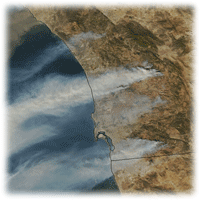
Fortunately, the vast majority of it will land in the ocean or in other natural places where it will be absorbed into the ecosystem. However, unfortunately, much of this smoke “dust” has settled on urban areas in yards, in parking lots, on building rooftops, within HVAC systems and inside homes and buildings. If you smelled smoke inside your home or building, the particulates got inside!
What is the big deal? The soot and ash will get cleaned up, washed away by rain (eventually), caught by air filters, etc., right? This is true, but until it does, fully does – which could take months or years – it remains a health problem. Why? you may ask.

First, by its very nature smoke particles can cause more health problems than ordinary particulate or dust. Particle size ranges from the course, highly visible and annoying ash, to the ultra-fine, microscopic soot that can pass through the defenses of the respiratory system into the deepest pockets of the lungs – something ordinary dust seldom does!
Add to that the fact that smoke particles are usually composed of tars, acids and assorted chemicals (nasty substances) in addition to the soot and ash, and you have a very high potential for health problems.
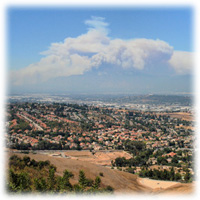
Secondly, a significant segment of the population – the very young, the elderly, those with allergies, asthma, heart or lung disease, bronchitis, etc. – can be adversely affected by exposure to even low levels of smoke particulate. Harmful levels can remain long after the fires have died out, due to the fact that the particles tend to settle everywhere, into every nook and cranny, and the smaller-sized (the most unhealthful) will pass through an ordinary vacuum cleaner or air filtration. Also, the smaller particles are invisible to the unaided eye unless present in huge volumes. This can lead to the false impression that after cleanup by ordinary methods all of the smoke contamination is gone, when in fact it is not. Fine soot’s tendency to easily aerosolize (disperse into the atmosphere) and remain suspended adds to the difficulty of completely removing it from building or home interiors and, an additional negative point puts it into the breathing zone of building occupants.
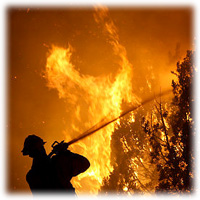
The blackened fire areas, which now serve as a continual source of more soot and smoke odor, are quite extensive and are adjacent to thousands of buildings and residences. Every time the wind blows, here comes a fresh supply of soot and ash into these nearby structures via the HVAC, windows, doors and other leaks in the building envelope.
Lastly, Southern California’s base air contamination is normally at such a high level that any additional pollution has an extraordinary effect in bringing on adverse health symptoms.
Thank you for the problem! Now what can be done about it?

To start, there are a few things I recommend that anyone whose house or building is impacted by smoke or ash should do, even if there is no apparent problem with odors, soot or ash particulate or unusual or adverse health symptom associated with smoke exposure (e.g., respiratory, lung or allergy problems). One, the structure’s interior should be thoroughly cleaned using a HEPA-filtered vacuum. Two, the air filter in the HVAC should be changed out using the most efficient replacement possible and the HVAC system interior inspected for soot or ash accumulation (and, of course, cleaned if contaminated). The idea is to lower additional exposure to residues so as to help head off possible longer-term effects.
If a problem exists, such as lingering odors indoors, adverse health effects associated with smoke contamination or continuing soot deposition on interior surfaces, then I recommend the above actions plus cleaning and deodorizing (by professionals using approved products per manufacturer instructions) of the HVAC system. Also, HEPA-filtered room air cleaners and/or negative ion generators are useful to continually clean the air until the problem abates. The proper and safe usage of ozone generators can clear up any odors. These actions should be promptly done to avoid more exposure.
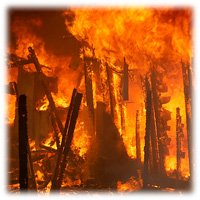
The worse situation is being adjacent to, or in the midst of, a burned area, as a continual supply of soot and ash is available for some time, especially when the wind blows.
All of the above remedies can be done to handle the accumulations, but the key to lowered human exposure and minimal contamination is in keeping the building envelope as tight as possible. Doors and windows should be kept tightly closed and the building positively pressurized. Economizer dampers should be adjusted to minimum settings consistent with codes. Any outside air should pass through an efficient air filtration as is practical. The first line of defense, if possible, filters over the OSA (outside air) inlet. Also, room air cleaners might be a necessary part of the effort to providing a habitable indoor space.
Sensitive individuals may have to be moved to a location away from the influence of the burned areas. As a word of warning, the home or building and its HVAC system may have to be cleaned and deodorized more than once in worst-case situations. Prevention of further intrusion indoors of soot and ash from the burned areas is vital for health and cleanliness.
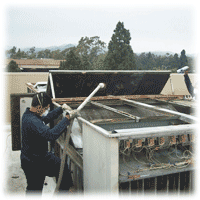
The main thing is to realize that the problem is not completely gone now that the fires are out. The fine particulates remaining in the outdoor areas, indoors and the interior of the HVAC systems can cause adverse health effects and should be promptly and effectively abated where it has accumulated in our interior living and working environments.
I hope this has been of help. Please call us if you have any questions.
Sincerely,
Geroge F. Machado
President and Founder